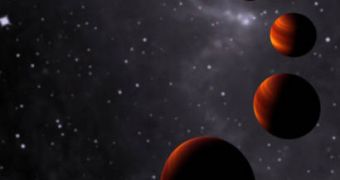Located about 1,600 light-years away from the Earth, in the Constellation Monoceros, the exoplanet CoRoT-1b, first discovered about two and a half years ago, is the first one whose day and night cycles were observed in optical wavelengths, as it orbited its star. The body was first discovered by the French CoRoT (Convection Rotation and Planetary Transit) instrument in Earth's orbit, and was one of the over 300 exoplanets found over the last decade. However, it proved to be the one that eventually revealed the secretes of temperature differences between its “day” and “night” sides, as the planet is tidally locked to its star.
Astrophysicists believed that all massive exoplanets, which are about the size of Jupiter, were locked around the stars they orbited in a formation known as a “tidal lock.” This means that the celestial bodies also have the same face turned towards the star at all times, while the other remains in total darkness. The same holds true for the Earth-Moon complex, as our natural satellite always shows us the same side. CoRoT-1b is what astronomers termed a “hot Jupiter,” a very massive planet revolving around its center of gravity at a very close distance.
In this particular case, the extra-solar planet only takes 36 hours to complete a full rotation. By now, astronomers have observed the peculiar formation using infrared wavelengths, but now they have managed to see it using nothing but optical frequencies for the first time. They have noticed tremendous temperature differences between the two sides of the planet. The one facing the star has an estimated surface temperature of about 3,600 degrees Fahrenheit (2,000 degrees Celsius), while the other one is completely dark, and probably much cooler.
“So we see a very large difference between the day side and the night side,” Space quotes Ignas Snellen as saying. He is an expert at the Leiden University, in the Netherlands, and also the author of a new study detailing the finds, published in the May 28th issue of the respected scientific journal Nature. He added that investigations revealed the fact that there was not much heat transfer going on between the two sides of the planet, which means that there's a very strong chance the “dark” one is a lot cooler than the other.
Despite their best efforts, the experts could not determine if any of the light the planet got was reflected back. If they can determine that it is, then this could mean that the celestial body either has oceans, clouds, or vegetation. In either of the three cases, the potential for discovery would be remarkable.

 14 DAY TRIAL //
14 DAY TRIAL //